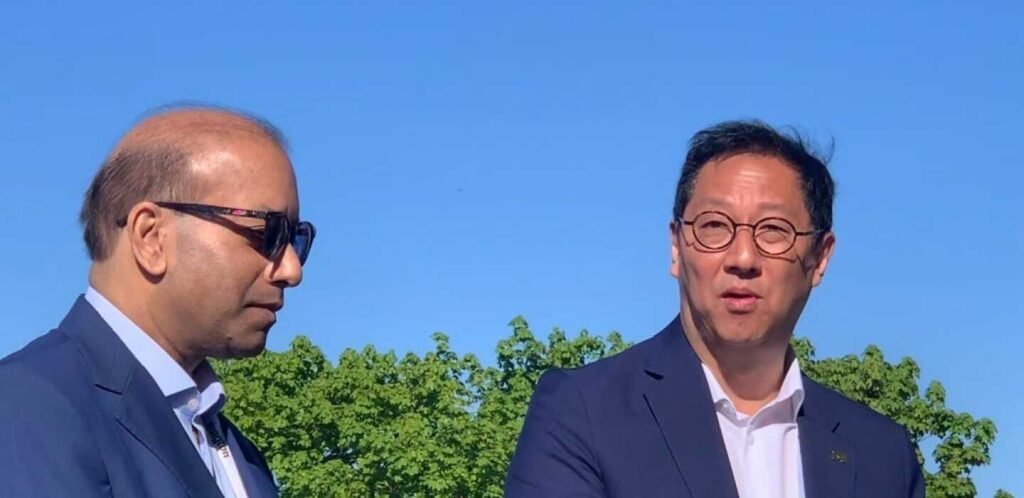(TNS) — The University of Michigan and the Detroit Regional Chamber of Commerce are teaming up to establish a new “innovation corridor” from Ann Arbor to Detroit to attract and retain entrepreneurs, tech professionals and startups to Michigan. University of Michigan President Santa Ono promises the effort will be an “economic spark for the entire state.”
The initiative, known as “Innovate Michigan,” announced at the Mackinac Policy Conference on Thursday, aims to keep Michigan’s universities and colleges’ best talent in the state and ensure funding for startups and other companies founded by researchers and university staff that aim to commercialize research and intellectual property.
“Our larger vision is to bring this forward by having a collaborative initiative at the table that involves multiple entities across higher education, the private sector, the civic sector and philanthropy,” said Sandy Baruah, CEO and president of the chamber.
Ono said the university will invest $1 billion over the next several years to bolster its innovation and economic development efforts, including initiatives already underway such as the UM Innovation Center in Detroit, which plans to invest $250 million in new programming for new certificate and degree programs that “really contribute to developing the workforce in our state.”
Ono also highlighted the University of Michigan’s work with Washtenaw Community College, General Motors and others to establish a Semiconductor Center of Excellence in Michigan.
As part of this investment, Ono said the University of Michigan is finalizing plans to build a new Innovation District on the University of Michigan’s North Campus, which will include several research buildings as well as an on-campus hotel and conference center that will provide space to host major national conferences and other large events.
“It will be the epicenter of the University of Michigan’s Ann Arbor Innovation District, attracting a growing number of world-class researchers and scientists along with industry leaders and serial entrepreneurs from across the state, and also attracting venture capital from around the world to invest in the innovation that will emerge from this new research corridor, making Michigan the place where all of these individuals come together,” Ono said.
“It’s right next to our scientists, faculty and staff and will be a place that will serve as an economic catalyst for Michigan.”
Innovate Michigan organizers say they hope to attract and retain mid-sized and large businesses to Michigan and attract Michigan degree graduates and high-tech entrepreneurs from around the country and the world.
“A key element of this effort is connecting entrepreneurs with leading companies already in Michigan so that entrepreneurial and innovative companies have more reason to stay in Michigan because we have better customers. We also foster spin-off collaborations and innovations from young companies working with leading companies,” Baruah said.
Ono and Baruah said they are forming an exploratory convening committee to develop a strategy, benchmark metrics, goals and timelines, and to consider best practices from other successful “innovation corridors.”
“Our objective is simply to assemble a broad coalition, to meet, to collaborate and, most importantly, to be prepared to take concrete, measurable action in the cause of building a strong innovation corridor that spans across southeast Michigan, not just Detroit and Ann Arbor but the rest of the region,” Baruah said.
The area’s main corridor runs north-south, starting in downtown Detroit and running north along Woodward Avenue to Birmingham, Bloomfield Hills, Pontiac and more.
But the new corridor would run east-west from downtown Detroit to Michigan Central Station and encompass other innovation “hubs” developed by the chamber and its partners, including the new University of Michigan Innovation Center in Detroit, the Michigan State University-Henry Ford Joint Healthcare Remote Innovation Center on Grand Boulevard, Detroit Metropolitan Airport, Ford Motor Co. in Dearborn and the University of Michigan campus in Ann Arbor, Baruah said.
Both leaders suggested they see the corridor as a way to better compete with peer states and regions to attract capital and high-tech entrepreneurs, with a stated goal of also working to develop “attractive” communities that will draw young professionals.
Ono said the University of Michigan will likely invest more than $1 billion in Innovate Michigan-related efforts over the long term, and he also hopes the university’s “strengthening” ties with national laboratories will attract talent and entrepreneurs to the state.
“The University of Michigan has received a $15 million investment from Los Alamos National Laboratory that will bring a level of computing technology that Michigan does not currently enjoy, which is essential to all of the goals we want to achieve as a state,” Ono said.
“This isn’t just an issue for the University of Michigan. It’s an issue for everyone in the state of Michigan, and for every other educational institution, and for businesses that rely on high-performance computing for a competitive advantage.”
Ono has experience working on a similar innovation corridor that launched between Washington state and British Columbia in 2016, when he was president of the University of British Columbia. In its first year, the collaboration launched a feasibility study for a new ultra-high-speed rail line from Portland, Oregon, to British Columbia.
“We are clearly focused on economic development, and when this president says we’re not just the University of Michigan, we’re a university for Michigan, he really means it,” said Sarah Hubbard, chair of the University of Michigan Board of Trustees.
“We’ve really been focused on how important it is to integrate the university into the state’s economic development functions, and also the importance of connecting with what our local partners are doing and our state partners and retaining students for jobs in the state.”
Ideally, the corridor would keep University of Michigan “spin-off” research within Michigan, which would help the state develop into a stronger economic development ecosystem for other elements such as venture capital, entrepreneurship and even mature companies, Hubbard said.
“I really want to stay here in Michigan and cycle with the University of Michigan,” she said.
©2024 The Detroit News. Distributed by Tribune Content Agency, LLC.

